“There’s a void underneath the houses that is filled with water — like a complete lake over there,” said Howard Brunet on August 24, just before his uncle Chris Brunet was about to sign the final paperwork on a new home.
Once he signed, Chris would become the first lifelong resident of Isle de Jean Charles to commit to moving into one of the newly built homes provided by Louisiana’s Office of Community Development (OCD). The New Isle subdivision is the first federally funded resettlement project built for a coastal community facing immense risk from the climate crisis.
“You all are sending out an inspector or whatever from the state or something — whatever damage they find, are we going to have to pay for that?” Howard asked.
Patrice Staton, a disaster recovery specialist with the OCD, told the Brunets that a contractor was already working on the drainage issues plaguing the new homes, adding that she was pretty sure the contractor already started fixing the issue at Chris’s house. The Brunets were further assured by a representative from Team Title, the company handling the closing, that the state’s New Home Warranty Act requires homebuilders to fix any issues related to the construction of their projects for a year, so they had nothing to worry about.
“I always said if I was going to move away from the water I wasn’t going to move into it,” quipped Chris Brunet, who went ahead and signed the last of the documents at the closing. In doing so, he accepted a forgivable five-year mortgage on a house he will own outright, payment free, as long as he meets certain conditions, including making the home in Gray, 40 miles north of Isle de Jean Charles on higher ground, his primary residence.
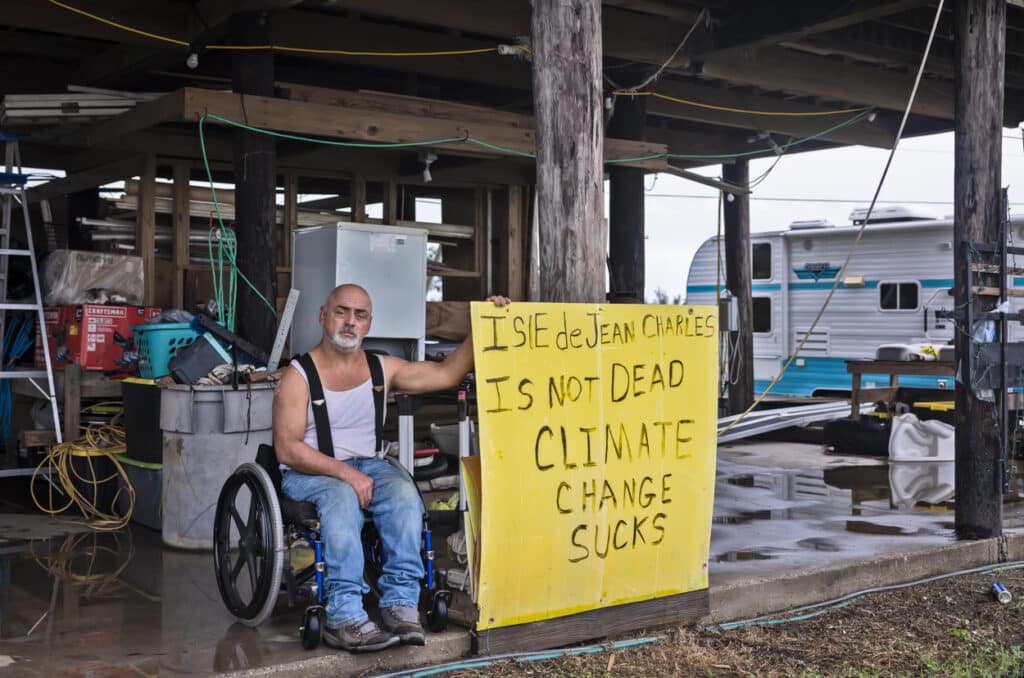
There was standing water under a yet-to-be-occupied home where the closing was held. As members of the media, OCD’s staff, some of the agencies’ partners, and Jean Charles Choctaw Nation Chief Naquin watched the signing move forward, I wondered if it was advisable to accept a house with an obvious engineering issue “as-is.” Standing water under new construction can signal subsidence, which can lead to structural issues, and the water also presents a breeding ground for mosquitoes.
Jean Charles Choctaw Nation Chief Albert Naquin, was asked to sign one document as a second witness, which he reluctantly agreed to do after making it clear that he didn’t want it to appear he supported the project in anyway.
Naquin’s tribe had been working on a visionary resettlement proposal for over a decade, partnering with the nonprofit Lowlander Center, scientists, and disaster specialists. In 2015, the Tribe allowed the state to use this proposal for its application to the U.S. Department of Housing and Urban Development’s (HUD) National Disaster Resilience Competition. The Tribe’s proposal, coupled with the low-income, Indigenous status of its members who still lived on the island, helped the state to win $92 million from HUD. $48.2 million of the total was earmarked to resettle the Tribe from its namesake historic homeland, the Isle de Jean Charles, a rapidly dwindling island about 80 miles southwest of New Orleans, at the edge of the Gulf of Mexico.
As previously reported by DeSmog, shortly after securing the federal funds in 2016, OCD radically transformed the Tribe’s proposal, revising its focus from relocating a tribal community impacted by climate change to relocating the island community. OCD justified the change by saying the state had determined not all residents on the island identified as part of the Tribe, and that limiting the project to a specific tribe could be seen as contrary to HUD’s rules and federal anti-discrimination laws.
The agency appointed its own steering committee without input from the tribal leaders, essentially cutting them out while publicly stating their input was still welcome. OCD chose partners it had previously worked with on other disaster recovery projects, including Louisiana Land Trust (LLT), a nonprofit created in 2005 to support buyouts after Hurricane Katrina and Rita through the State’s Road Home Program. (LLT recently received an unfavorable audit.) Other partners in The New Isle included CSRS, an architectural and engineering firm tasked to create the master plan for the project, and Team Title, the closing company.
By 2019, the Tribe and the Lowlander Center disassociated themselves from the project. At that point the only thing the Tribe and the state agreed on was that the island’s residents were in need of relocation, and that a suitable site for the project was a 515 acre sugarcane field in Gray, Louisiana, that the Tribe had identified and purchased for the project.
Naquin shared with me that he had no desire to be present for the first move-ins, when I met him at the site on August 24. He feels that the OCD, which he refers to as the “Office of Community Destruction,” often portrays him as a spoiler and that the agency had divided the Tribe since taking over the project. However, Chris Brunet asked him to perform a smudging ceremony in his new house, an Indigenous custom of burning sage to cleanse the space, so he put his own feelings aside and showed up.

But he was glad he came. As a witness for Brunet, he realized there was only one set of documents to sign at the closing. He vehemently objected to this, pointing out that at closings there are always two sets of originals, one for the buyer and one for the seller. But he was assured by the title company handling the closing that copies would be made and not altered, as Naquin pointed out they could be. Historically, signing documents provided by the U.S. Government has not served Indigenous people in the Untiled States well. Naquin sees this lack of cultural sensitivity at the closing as reflective of the state’s entire handling of the project despite its continued claim to celebrate the island’s culture.
“The island residents that move to The New Isle are screwed,” Naquin told me after the closing. In his view no one should have accepted a new house until the engineering issue leading to the standing water was resolved.
As far as he knows, the only assurances the new homeowners have that repairs will be easy and done right come from those tied to the project. He can’t think of any compelling reason for the OCD pushing forward with closings before engineering snafus were fixed, unless they had a deadline to meet. Naquin asserted that had he and other tribal council members remained involved, Brunet and eleven other families who signed paperwork that day would never have been put in the position of accepting homes that had a glaring issue.
He predicts that The New Isle homes will end up like the homes in Brad Pitt’s “Make It Right” housing development, another well-intentioned project to help people impacted by climate-change-fueled Hurricane Katrina. Pitt’s nonprofit, the Make It Right Foundation, offered homeowners in New Orleans’ Lower Ninth Ward — a working-class, predominantly Black neighborhood, where most of the homes were totaled by Hurricane Katrina — a chance to buy affordable, environmentally friendly homes. Many of the homes started to have structural issues after a few years and the foundation fell short in making repairs, leading to some of the 106 homes being demolished and spurring legal fights between homeowners and the foundation. A few days before The New Isle development’s move-in date, the participants in the Make It Right housing development got a $20.5 million settlement, after years of fighting for justice.
State Rep. Tanner Magee, whose district includes the Isle de Jean Charles and The New Isle community, attended the move-in press conference. He shares many of the chief’s concerns regarding the resettlement project.
“It’s definitely concerning when you spend all this money and you still have basic issues like water under houses,” Magee said. “Hopefully it’s something that can be fixed easily.”
“I hope that the state is better than the Make It Right Foundation was and that we will stand by what we’ve delivered better than they did,” Magee continued. “I have no assurances at this time, you know, but I can give my commitment to do everything in my power to give those assurances.”
Naquin and Magee both said they worry some of the Tribe’s members who take the “free” houses won’t be able to afford the costs associated with five-year forgivable mortgages because the assessed value of the homes in The New Isle is double the $150,000 the Tribe’s original plan had budgeted for. Even homes valued at $150,000 would be hard for some members to afford after insurance, property taxes, upkeep and utilities Naquin said, which is why the Tribe’s resiliency strategy in its plan would have generated funds to cover any community members’ shortfalls.
Even if the state covers the insurance, which it indicated it would for the first group of qualified participants, it has yet to explain how and where that money would come from.
The Tribe’s original resiliency strategy included plans to power the homes with a solar array, which was meant to generate both affordable energy and create revenue to supplement tribal members’ expenses. But the state scrapped these plans.
The OCD website explains that “the originally planned solar farm is not economically viable due to high initial infrastructure costs, as the site will not generate sufficient revenue to justify the costs. The homes are being designed, built and verified as ENERGY STAR Certified Homes, which are 20% – 30% more efficient than the average home. This energy efficiency will provide sufficient utility savings at lower costs than solar panels.”
However, Naquin pointed out that even if the homes are energy efficient, they are much bigger than the island’s residences, so utility bills will be considerably more.
OCD did not offer an estimate of how large those bills would be when I asked.
Janice Lovett with OCD’s communication team wrote in an email “any rational assessment of a comparison between the construction methods of the houses on Isle de Jean Charles and the houses at The New Isle would indicate a dramatic reduction in energy costs.”
Marvin McGraw, OCD’s communications specialist, confirmed by email that the state hasn’t established plans to generate funds for residents who can’t meet their new, greater financial obligations. “There are various economic development activities and partners under consideration for revenue generating activities that will provide funding to support the individual residents in their new homes, as well as to continue to enhance the community more generally,” McGraw said. “Specifics on those partners and activities are not yet available.”
At a celebratory press conference following the closing of Brunet’s home, the first of 12 closings at The New Isle, Pat Forbes, the executive director of the OCD and the Gov. John Bel Edwards celebrated the state’s accomplishment. Both thanked tribal leaders for helping make the project possible and recognized Chief Naquin specifically, although no one from the state had invited him to the move-in day.

While 42 of the island’s households qualified for a home in The New Isle, only 37 households are in line. OCD offered residents who moved off the island before 2012 lots at the site for free, but if they take them they will have to pay to build their own homes. “25 former residents have applied and been determined to be eligible for those lots,” McGraw told me. “They are at varying stages of progress in getting their financing and construction planned,” but currently it is unclear how many other former island residents will move to the site, leaving much of the 515 acres as of yet to be spoken for.
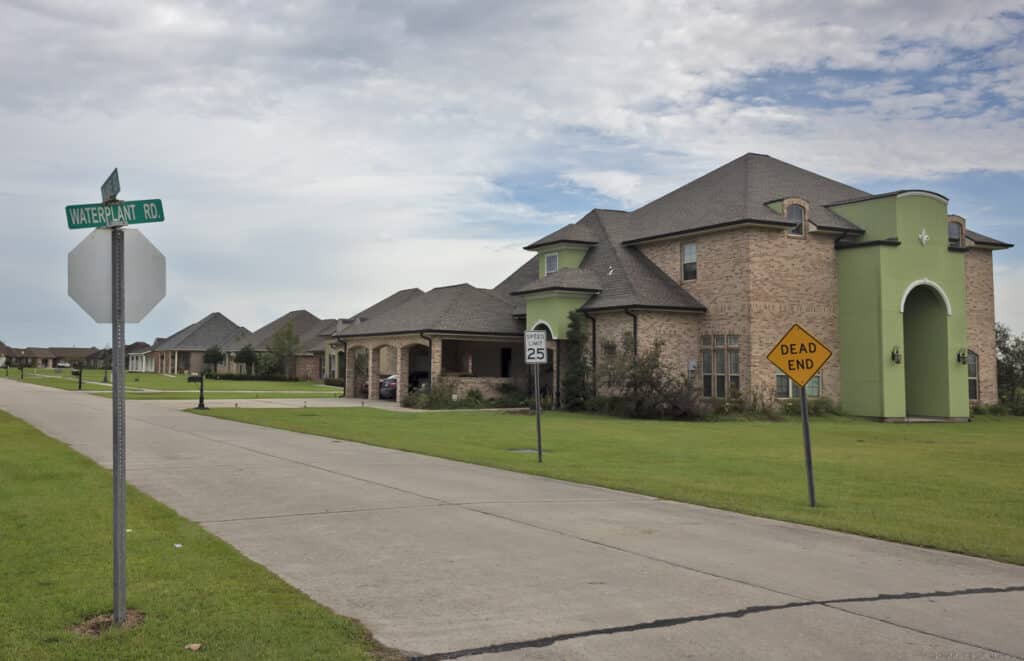
Magee’s largest concern all along has been what happens if very few tribal members end up living in the development. Both tribal members and residents in the nearby more affluent Waterplant Road neighborhood worry about that too.
Opponents of the project tried to get the Houma-Terrebonne Regional Planning Commission to stop the subdivision from being permitted at a February 2019 meeting. Many voiced the opinion that they expect that the development will become a typical low-income subdivision that will bring down their home values.
Magee is aware that the new subdivision is being blamed for negatively impacting the drainage infrastructure in the Waterplant Road neighborhood, and that residents from that community warned the Planning Commission, OCD, and its selected partners at the February 2019 meeting that the project would increase their flood risk. After work began on The New Isle development, Waterplant Road neighborhood residents say that standing water covers their roads and lawns after even a regular downpour, something that didn’t happened before the subdivision took form.
Magee said he’d never seen any drainage studies to assure him the development wouldn’t cause the issues the residents are complaining about. Add to that a new FEMA camp for people impacted by Hurricane Ida that recently sprung up between The New Isle and the Waterplant Road neighborhood that he has yet to see drainage studies on either, and he has no assurance he can offer his constituents that the camp won’t add to the area’s drainage woes.
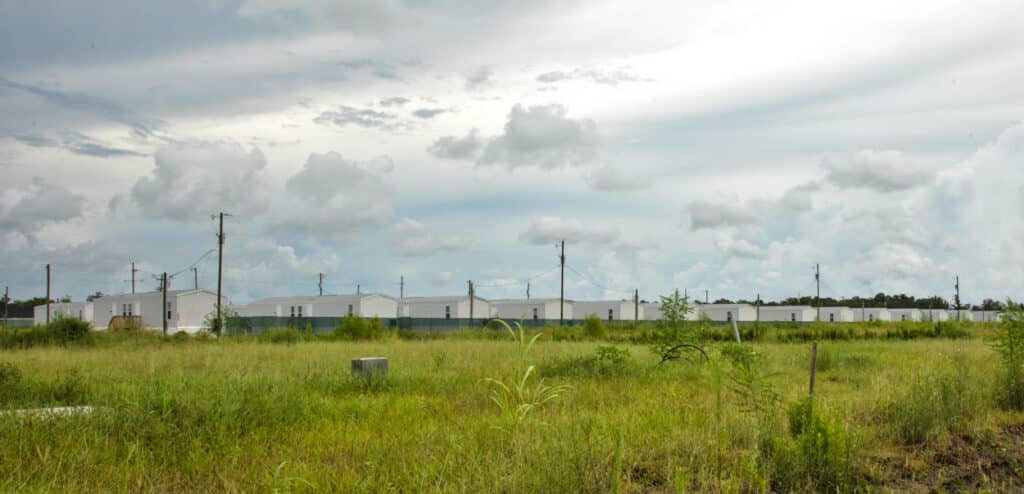
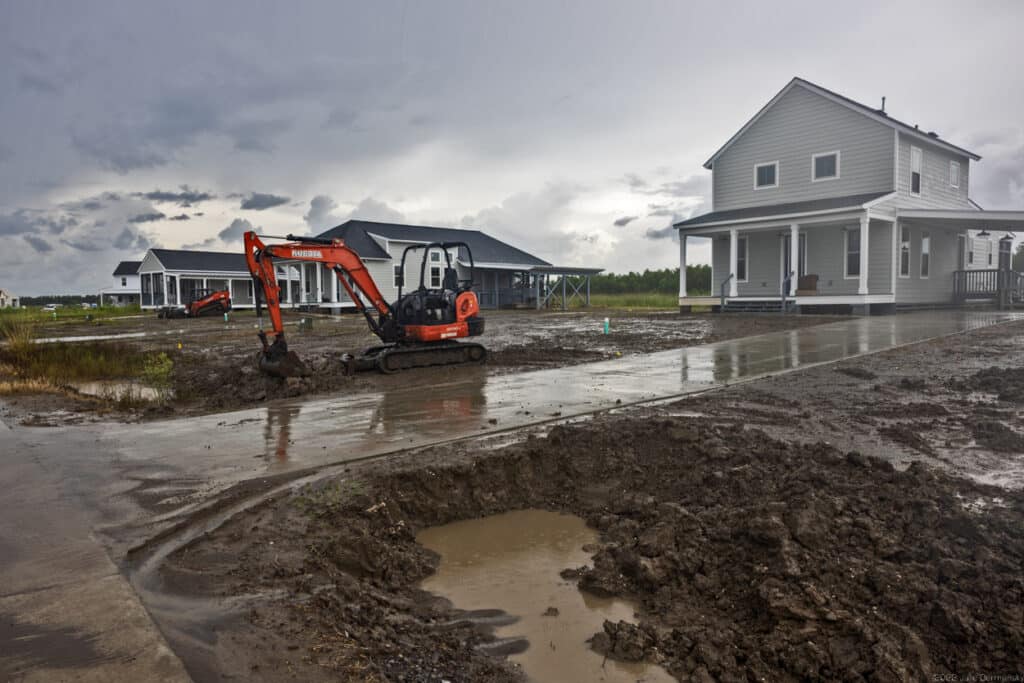
During the August 24 move-in event, OCD employees and its partners maintained that the water under the house would be resolved in the next couple weeks. “The water under the homes is a result of the built-up landscaping around the homes,” Lovett later said by email, adding that the state’s contractor was taking steps to improve drainage, such as regrading lots and adding fill under houses. “The extensive amount of rain taking place each day on site has slowed the progress of this work down, therefore it could not be 100% complete prior to closing.”
Problems with sewage and drainage had already delayed plans for residents to move in on August 5. “A last-minute inspection by the Parish found some issues with the sewage and drainage infrastructure,” McGraw told me via email, on August 4.
I went out to the site the following day, to see what was going on and found standing water under the homes, so I found it surprising when McGraw got back to me on August 16 and explained with more specificity that the issue causing the delay was had nothing to do with the drainage problems under the home. “While installing a cable, ATT mistakenly drilled through 7 sewer pipes connecting the homes to the main line,” he wrote.
Despite repeated questioning, OCD did not specify when the contractor first became aware of the problem. “The drainage issue was discovered during a significant rain event after landscaping was completed,” McGraw said in an email.
Some of the participants in the resettlement program who have been monitoring construction progress, said the issue was apparent to them over a year ago before Hurricane Ida hit Louisiana’s coast as a Category 4 storm. Many of the homes were nearly complete before August 31, 2021, but Ida ended up delaying construction, which had already been slowed down due to the pandemic.
Rene John Hebert, who lives in the Waterplant Road neighborhood and is a supervisor on construction sites, has 32 years of experience working with engineers and drainage issues in the area. He disagrees with OCD’s assessment about the complexity of the drainage problem.
“It likely won’t be easy to fix,” he said. “The land wasn’t prepared right. It hasn’t been compacted enough or given the time to let sit long enough before the structures were built. That is why rain is collected under the homes as the soil is subsiding.” According to him, if The New Isle’s homes had been built on pilings, subsidence would not have been a problem. But because they weren’t, the issue could linger indefinitely.
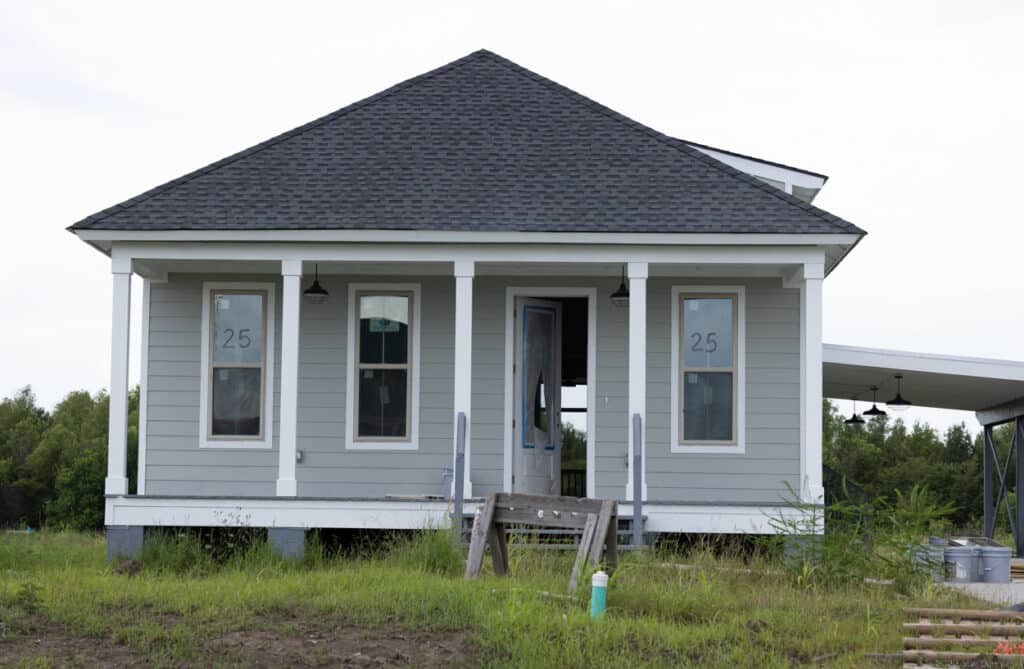
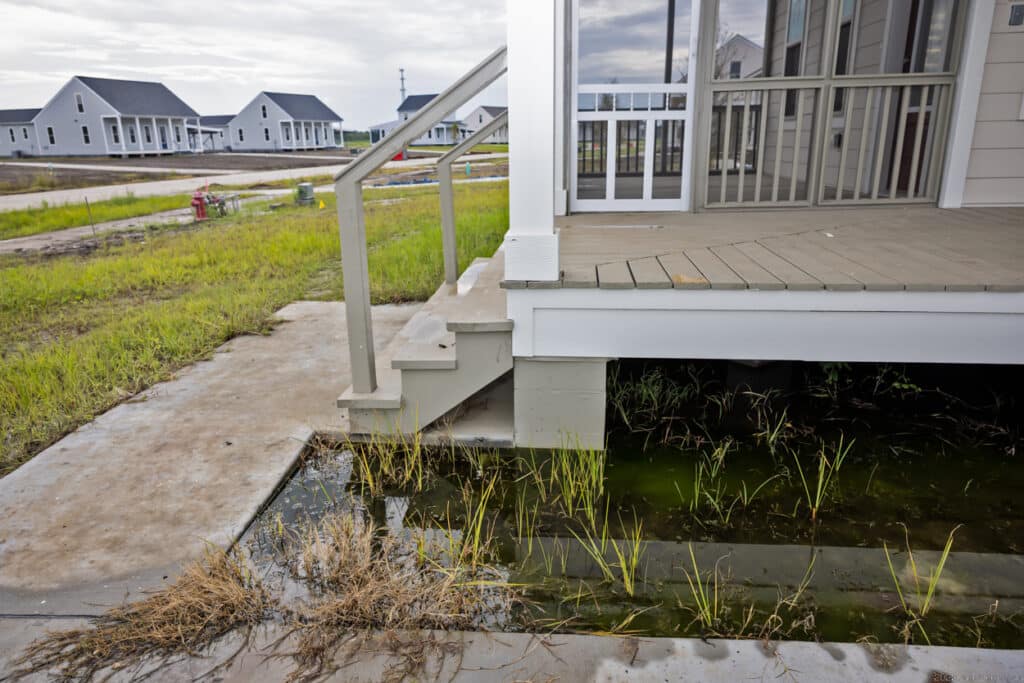
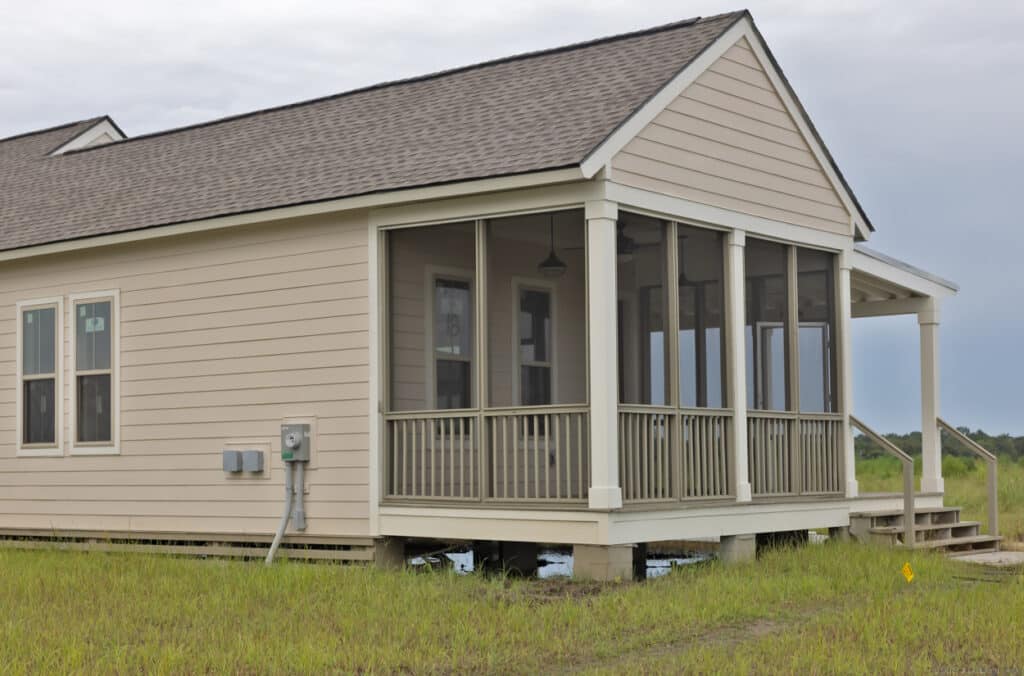
Hebert said a mold test “definitely” should have been done during the home inspections if water had been under the at-times partially completed homes on-and-off for a year. However, those tests are not required if no obvious signs of mold are present, so he wouldn’t be surprised if none were done. One advantage of not testing for mold is “If you don’t know it is there, you don’t have to disclose it,” he pointed out.
A representative of the Louisiana Land Trust present on closing day, who did not give me his name, minimized the standing water issue and stated that building the homes on pilings was not called for. When pressed for reasons he said, “A soil test done by the contractor led to the contractor’s choice to use spread footings instead of pilings,” adding that those test are rarely wrong.
Forbes also minimized the standing water issue and said he didn’t think any tests for mold were done. “The questions never came up in our construction management discussions or anything with all the contractors and program management people. It just hasn’t,” he said. “There’s sprayed foam insulation underneath” he explained, which he said would prevent mold from being an issue. “But it is a good question,” he acknowledged.
His comment made me wonder if a third-party inspector unaffiliated with the project did an inspection on any of the homes. Not only is the standing water a potential risk for mold but some of the structures were not sealed for periods of time over the course of construction, exposing the works in progress to rain and humidity. Given this, even though no mold is visible in the homes, a home inspector likely would have advised potential home buyers to check for it anyway.
I asked OCD who performed the inspections and whether the home recipients were present when the homes were inspected.
OCD identified CSRS as a third-party inspector — despite the company’s role in the project. And while the agency didn’t specify that the new homeowners weren’t present when CSRS inspected the home, I was informed that it offered each homeowner an opportunity to perform their own walkthrough at least one week prior to the closing with an OCD and/or Louisiana Land Trust representative present.
Brunet told me he did a walkthrough with a representative of OCD and all the issues he flagged, except the standing water, were taken care of before the closing. “I know a lot about houses,” he told me, “so I knew what to look for.” However, he worries that some of the other tribal members might have overlooked some of the issues he caught.
“Few on the island have any experience with buying homes,” Chantel Comardelle, executive secretary for the Jean Charles Choctaw Nation told me, so it doesn’t surprise her that no one thought to hire their own. She finds it appalling that the state didn’t set aside money from the $48 million for the participants to hire their own inspectors, and thinks that not encouraging them to do so was unethical.
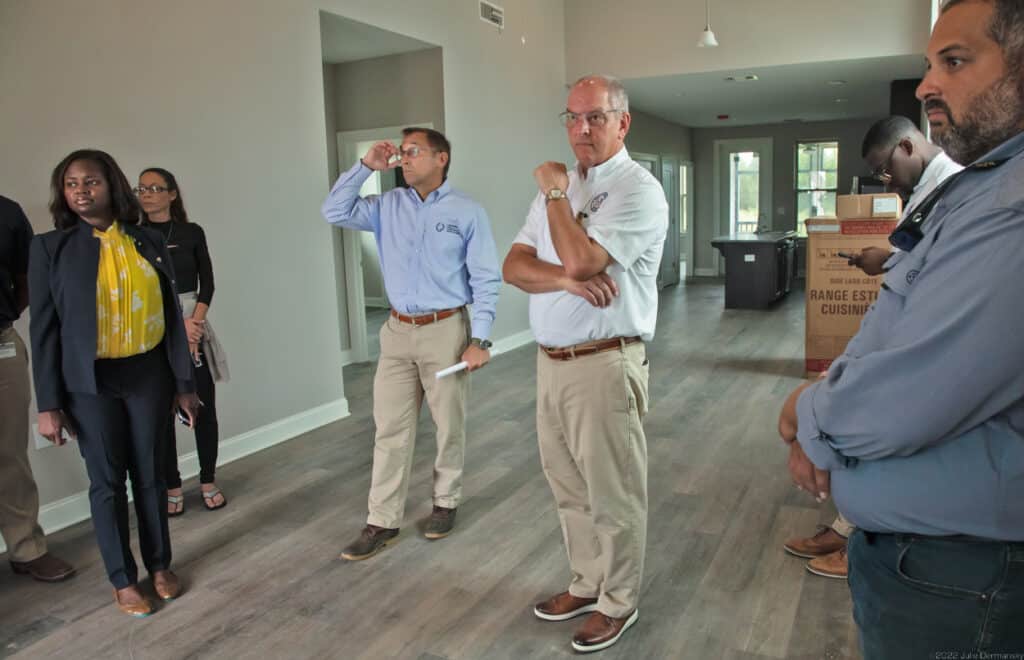
After the celebratory press conference, Forbes escorted the governor on a tour of a few of the homes. Edwards didn’t express any concern about the visible drainage issues. Instead, he expressed his displeasure that there were not enough trees, a point he remarked on at the press conference too. He let everyone know he isn’t a fan of subdivisions and plans have the state do more to make sure The New Isle doesn’t look like one.
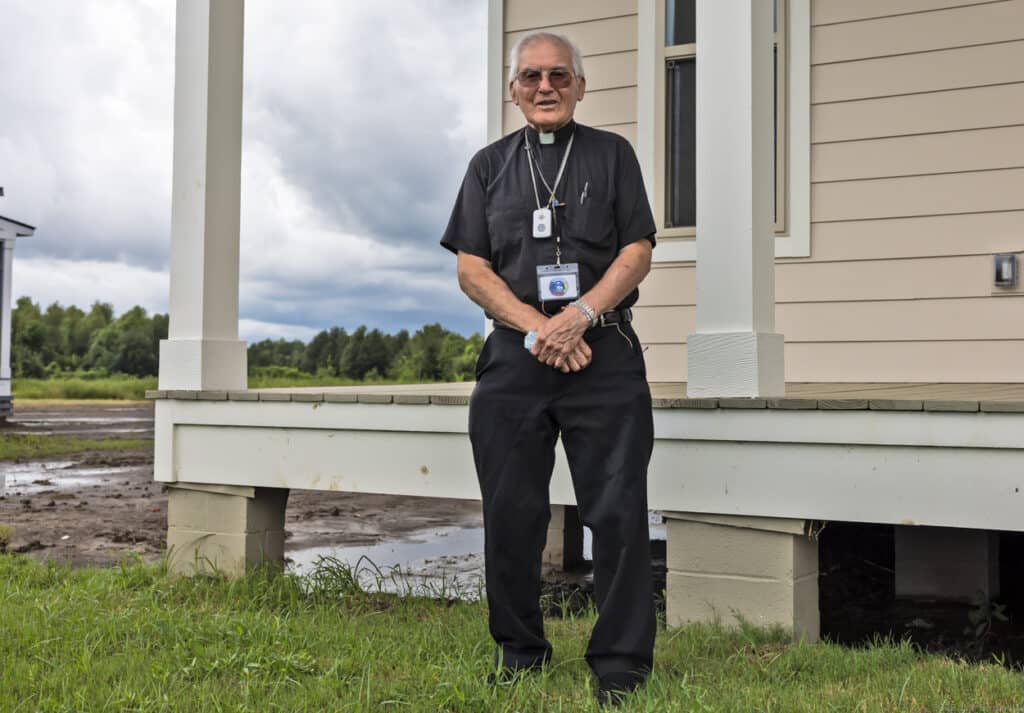
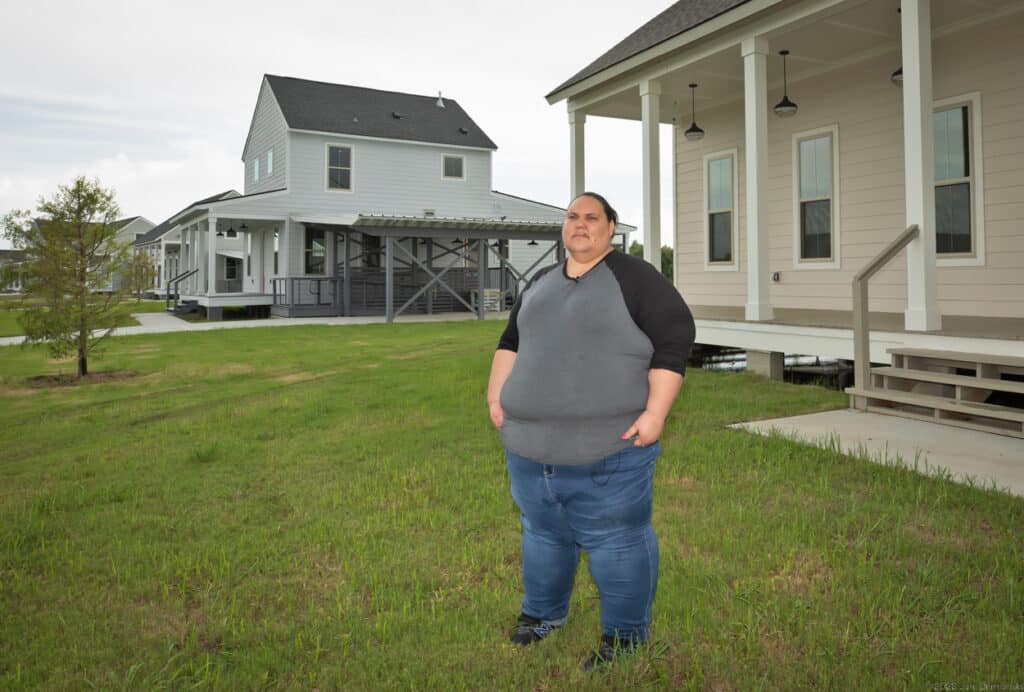
The Tribe’s status as a marginalized Indigenous community was key to Louisiana’s proposal being selected for the federal grant, Comardelle told me after closing day. And now, she believes that the state is further victimizing the Tribe with the gift of “free” defective homes. She sees the rollout of the resettlement project as an example of environmental racism at its worst instead of a roadmap for other communities in need of relocation due to the climate crisis. “Our voice was used to get the money,” she said, “and then strategically taken out.”
The post Isle de Jean Charles Community Members Moved into the First Federally Funded Resettlement Project in Louisiana Despite Visible Engineering Issues appeared first on DeSmog.











